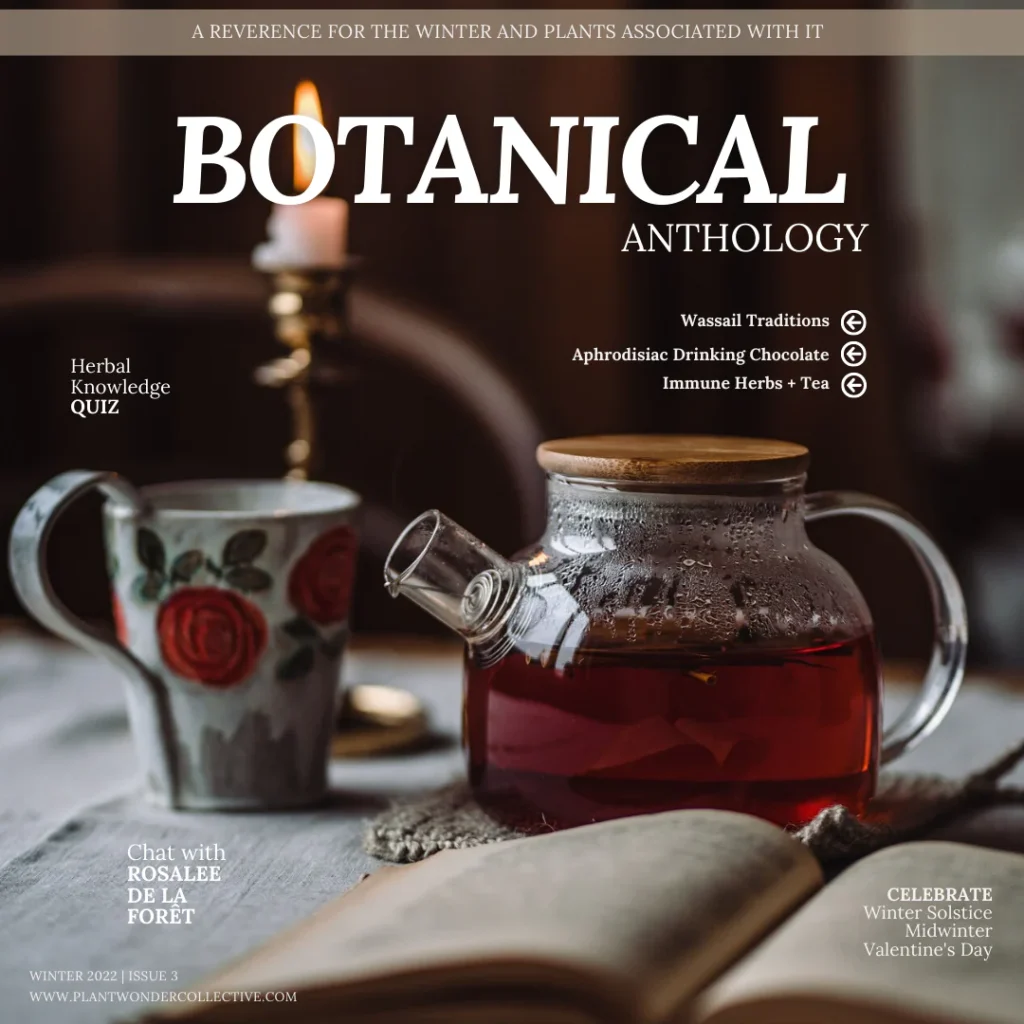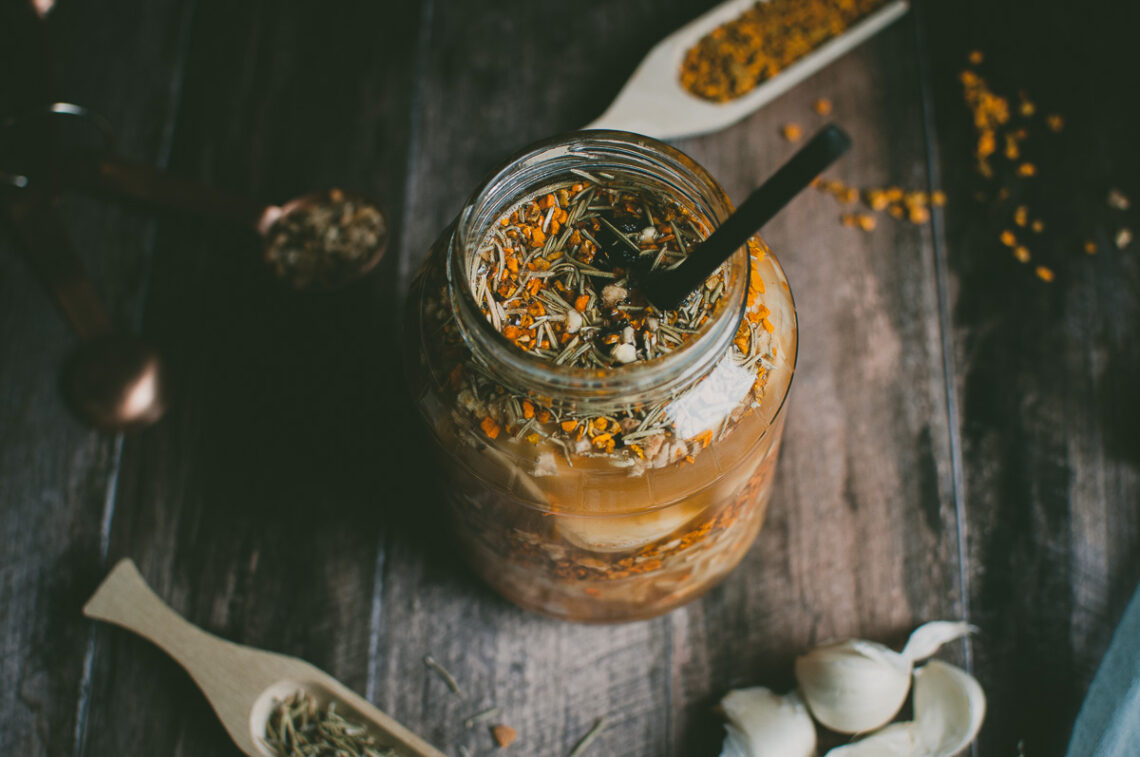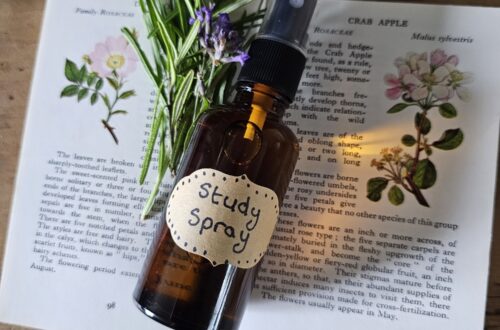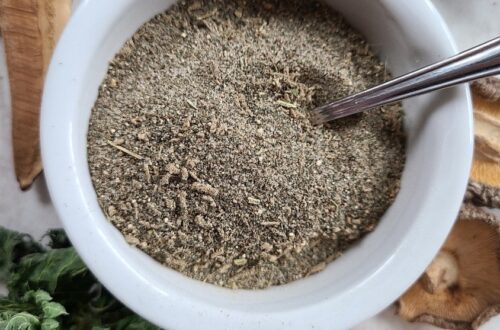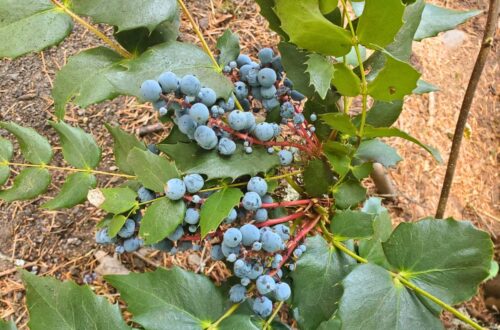Last Updated on December 1, 2025
This recipe is an excerpt from the article “Fire Cider” by Katie Jo Muschiana with photos by Kristen Wood featured in the Winter Vol 1 | Issue 3 | 2022 edition of Botanical Anthology. Our herbal magazine, featuring remedies, recipes and projects with plants for the autumn season, can be purchased as a digital version here and as a printed version here.
We just welcomed Winter here in the Northern Hemisphere. This cold time of year where it’s even more important to support our immune system’s natural intelligence. One of the best remedies to have on hand is Fire Cider.
Fire Cider seems to have grown quite a reputation and is a delicious concoction that bursts your taste buds open. There is something ancient about the spirit of the remedy. If you have ever had Fire Cider or anything similar, you experience the medicinal qualities of the ingredients almost immediately, a perfect blend of sour, spicy, drying, pungent, warming and sweet. It can be made with ingredients that most people have already in their cupboard and also invites a whole realm of herbal possibility.
Fire Cider is a root tonic containing medicinal roots from the garden and the field. It is an herbal vinegar- extracting all the delicious flavors and nutrients from so many lovely medicinal herbs. It is a garden dressing- herbs, spices, roots and garden vegetables soak in this food medicine… And it is a delicious oxymel, adding a sweet balance of honey to the mix.
When talking about Fire Cider, you have to mention Rosemary Gladstar! She is the fairy godmother of modern herbalism and has had a huge impact on many young herbalists’ lives with her wisdom and knowledge of herbs, plants and traditions. She is the one who first coined the term “Fire Cider” with her famous folk recipe which she shares freely and widely. Fire Cider has since become a common term that herbalists and medicine makers use to describe this autumn root tonic. With three others, she fought legally to ensure this recipe was protected to never be trademarked and capitalized on. They won the “Free Fire Cider” lawsuit, determining “fire cider” is a free term to be used and shared by everyone.
Fire Cider can be made in countless different ways. You can always follow Rosemary’s basic recipe, but it’s worth slowly venturing out and starting to include your own plant wisdom, taking into account what you grew in your garden and what energetics you want to focus on during the cold and flu season.
Let’s break down a couple key ingredients that make this a fantastic remedy for immune system support:
Ginger Root: warming and stimulating, ginger has a huge influence on the digestive system; specifically nausea, morning sickness, appetite, indigestion and a whole host of digestion complaints. It increases circulation and stagnant blood and helps relieve uterine cramps, muscle cramps and spasms by stimulating and warming up tissues and muscles. Ginger helps reduce inflammation and assist with symptoms of cold and flu, specifically associated with fever and chills.
Onion: Onions are rich in inulin which is an amazing source of prebiotics! Prebiotics are needed to help the good bacteria in your gut stay healthy and flourish. They are directly related to digestive and immune system health. Onions are also anti-inflammatory and are high in sulfur compounds, vitamins and minerals, antioxidants, and antibacterial properties.
Horseradish: Along with antibacterial properties and high antioxidants, horseradish’s pungent and spicy flavor is an amazing medicine for sinuses and overall respiratory health. Particularly with cold and flu. If you have ever smelled or tasted horseradish, you have likely experienced the medicinal benefit of burning your throat and nose, perfect for relieving sinus pressure!
Garlic: Garlic is an immune powerhouse. It is antiviral, antibacterial, antiseptic, anti parasitic, supports cardiovascular health and circulation. It supports our bodies’ own detoxification processes. It helps nourish and support the body through nutrition and enhances the immune system to fight off and protect from illness.
Cayenne Pepper: High in capsaicin, cayenne is warming, spicy and drying. It helps regulate metabolism and digestive health and joint and muscle pain. If you have ever tasted cayenne you have probably experienced its medicinal characteristics. It can burn the throat and the sinuses but also help loosen pressure in the sinuses.
Apple Cider Vinegar: ‘ACV’ has so many medicinal properties which is why its many herbalists choose to make herbal vinegars! This vinegar is made from fermented apples, and it’s filled with tons of vitamins and nutrients. It helps with digestion, blood sugar regulation, acid reflux and the body’s overall detoxification processes. ACV contains healthy bacteria which helps support the digestive and immune system.
Materials
- ½ c horseradish root, fresh, grated
- ½ c onion, fresh, chopped
- ¼ c garlic, fresh, chopped
- ¼ c ginger, fresh, grated
- ¼ c turmeric root, fresh, chopped
- 1-2 cayenne peppers, fresh or dry, chopped or ¼-½ tsp powdered
- 1-2 jalapeno peppers, fresh, chopped
- 1-2 lemon slices
- Raw unpasteurized apple cider vinegar
- Raw honey to taste
- Mason jar
- Plastic mason jar lid
- Optional ingredients: echinacea root, rose hips, medicinal mushrooms, burdock root, other peppers of choice, any other herbs and ingredients that you might want to add. This can change per batch, get creative!
Method
Place herbs in a half-gallon canning jar and cover with enough raw unpasteurized apple cider vinegar to cover the herbs by at least three to four inches. Cover tightly with a tight fitting lid.
Place the jar in a warm place and let it sit for three to four weeks. Best to shake every day to help in the maceration process.
After three to four weeks, strain out the herbs, and reserve the liquid. Add honey ‘to taste’. Warm the honey first so it mixes in well.
Katie Jo is the creator of Woven Apothecary intentional herbal products through her website and local markets. She offers a seasonal printed zine series called “Medicine Through the Seasons”. This is an excerpt from the Autumn Edition. Find her on Instagram at @woven.apothecary.
Kristen Wood is a mama of two young boys, photographer, author of Vegetarian Family Cookbook, Fermented Hot Sauce Cookbook, and Hot Sauce Cookbook for Beginners, and creator of MOONandspoonandyum.com, a gluten-free vegetarian food blog and SchisandraAndBergamot.com, a botanically-inspired blog. Find her on Instagram at @schisandra.bergamot and @moon.and.spoon.and.yum.
